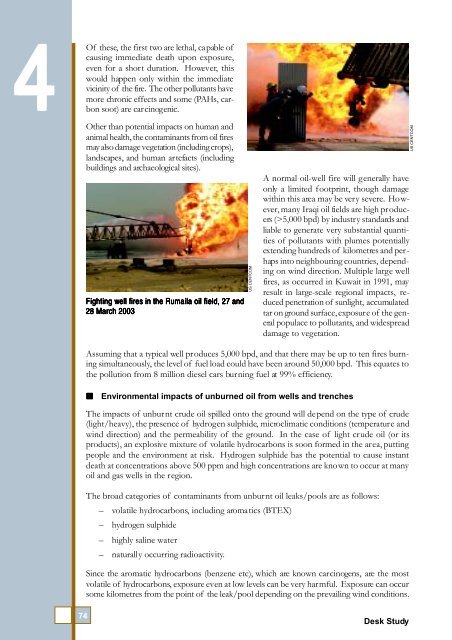Desk Study on the Environment in Iraq Desk Study on the ... - UNEP
Desk Study on the Environment in Iraq Desk Study on the ... - UNEP
Desk Study on the Environment in Iraq Desk Study on the ... - UNEP
You also want an ePaper? Increase the reach of your titles
YUMPU automatically turns print PDFs into web optimized ePapers that Google loves.
4<br />
Of<br />
<strong>the</strong>se, <strong>the</strong> first two are lethal, capable of<br />
caus<strong>in</strong>g immediate death up<strong>on</strong> exposure,<br />
even for a short durati<strong>on</strong>. However, this<br />
would happen <strong>on</strong>ly with<strong>in</strong> <strong>the</strong> immediate<br />
vic<strong>in</strong>ity of <strong>the</strong> fire. The o<strong>the</strong>r pollutants have<br />
more chr<strong>on</strong>ic effects and some (PAHs, carb<strong>on</strong><br />
soot) are carc<strong>in</strong>ogenic.<br />
O<strong>the</strong>r than potential impacts <strong>on</strong> human and<br />
animal health, <strong>the</strong> c<strong>on</strong>tam<strong>in</strong>ants from oil fires<br />
may also damage vegetati<strong>on</strong> (<strong>in</strong>clud<strong>in</strong>g crops),<br />
landscapes, and human artefacts (<strong>in</strong>clud<strong>in</strong>g<br />
build<strong>in</strong>gs and archaeological sites).<br />
Fight<strong>in</strong>g well fires <strong>in</strong> <strong>the</strong> Rumaila oil field, 27 and<br />
28 March 2003<br />
US CENTCOM<br />
A normal oil-well fire will generally have<br />
<strong>on</strong>ly a limited footpr<strong>in</strong>t, though damage<br />
with<strong>in</strong> this area may be very severe. However,<br />
many <strong>Iraq</strong>i oil fields are high producers<br />
(>5,000 bpd) by <strong>in</strong>dustry standards and<br />
liable to generate very substantial quantities<br />
of pollutants with plumes potentially<br />
extend<strong>in</strong>g hundreds of kilometres and perhaps<br />
<strong>in</strong>to neighbour<strong>in</strong>g countries, depend<strong>in</strong>g<br />
<strong>on</strong> w<strong>in</strong>d directi<strong>on</strong>. Multiple large well<br />
fires, as occurred <strong>in</strong> Kuwait <strong>in</strong> 1991, may<br />
result <strong>in</strong> large-scale regi<strong>on</strong>al impacts, reduced<br />
penetrati<strong>on</strong> of sunlight, accumulated<br />
tar <strong>on</strong> ground surface, exposure of <strong>the</strong> general<br />
populace to pollutants, and widespread<br />
damage to vegetati<strong>on</strong>.<br />
US CENTCOM<br />
Assum<strong>in</strong>g that a typical well produces 5,000 bpd, and that <strong>the</strong>re may be up to ten fires burn<strong>in</strong>g<br />
simultaneously, <strong>the</strong> level of fuel load could have been around 50,000 bpd. This equates to<br />
<strong>the</strong> polluti<strong>on</strong> from 8 milli<strong>on</strong> diesel cars burn<strong>in</strong>g fuel at 99% efficiency.<br />
• Envir<strong>on</strong>mental impacts of unburned oil from wells and trenches<br />
The impacts of unburnt crude oil spilled <strong>on</strong>to <strong>the</strong> ground will depend <strong>on</strong> <strong>the</strong> type of crude<br />
(light/heavy), <strong>the</strong> presence of hydrogen sulphide, microclimatic c<strong>on</strong>diti<strong>on</strong>s (temperature and<br />
w<strong>in</strong>d directi<strong>on</strong>) and <strong>the</strong> permeability of <strong>the</strong> ground. In <strong>the</strong> case of light crude oil (or its<br />
products), an explosive mixture of volatile hydrocarb<strong>on</strong>s is so<strong>on</strong> formed <strong>in</strong> <strong>the</strong> area, putt<strong>in</strong>g<br />
people and <strong>the</strong> envir<strong>on</strong>ment at risk. Hydrogen sulphide has <strong>the</strong> potential to cause <strong>in</strong>stant<br />
death at c<strong>on</strong>centrati<strong>on</strong>s above 500 ppm and high c<strong>on</strong>centrati<strong>on</strong>s are known to occur at many<br />
oil and gas wells <strong>in</strong> <strong>the</strong> regi<strong>on</strong>.<br />
The broad categories of c<strong>on</strong>tam<strong>in</strong>ants from unburnt oil leaks/pools are as follows:<br />
– volatile hydrocarb<strong>on</strong>s, <strong>in</strong>clud<strong>in</strong>g aromatics (BTEX)<br />
– hydrogen sulphide<br />
– highly sal<strong>in</strong>e water<br />
– naturally occurr<strong>in</strong>g radioactivity.<br />
S<strong>in</strong>ce <strong>the</strong> aromatic hydrocarb<strong>on</strong>s (benzene etc), which are known carc<strong>in</strong>ogens, are <strong>the</strong> most<br />
volatile of hydrocarb<strong>on</strong>s, exposure even at low levels can be very harmful. Exposure can occur<br />
some kilometres from <strong>the</strong> po<strong>in</strong>t of <strong>the</strong> leak/pool depend<strong>in</strong>g <strong>on</strong> <strong>the</strong> prevail<strong>in</strong>g w<strong>in</strong>d c<strong>on</strong>diti<strong>on</strong>s.<br />
74<br />
<str<strong>on</strong>g>Desk</str<strong>on</strong>g> <str<strong>on</strong>g>Study</str<strong>on</strong>g>

















